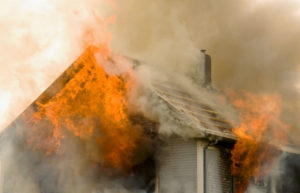(While the following information is essentially a reprint from an article from the Volume 4, Number 6, March 1983 edition of SNEWS, ISN: 0271-1060, written by the then editor, Jay Hensley, the information remains extremely relevant for today’s homeowners! )
A sheet-rock or plaster wall won’t burn. FALSE
- If the sheetrock or plaster gets hot enough, wood lathing or studs can indeed catch fire. Only a solid masonry wall at least 8” thick is truly fire-resistant. Even this type of construction will gradually crumble under constant intense heat.
Asbestos paper, sheet metal, asbestos millboard, or a brick or stone veneer applied to a wall will fireproof it. FALSE
- These fire resistant materials will conduct heat to the wall, which will ignite if it gets hot enough.
A stove board made of heavy sheet metal or asbestos millboard will protect the floor under a stove. FALSE
- If a stove radiates a high degree of heat downward, such a stove board could be inadequate. It will conduct heat through the combustible floor.
One layer of solid brick makes a safe base for a stove. FALSE.
- It takes at least 8 inches of well mortared brick or brick set in several inches of dirt or sand.
You can safely run a piece of stovepipe through a wall if you use a fireclay thimble or leave a few inches of space between it and combustible construction materials. FALSE
- You must allow 18” of clearance UNLESS you use a ventilated metal thimble three times the diameter of the stovepipe or use a section of approved Class A all- fuel metal chimney with 2 inches of clearance from combustibles.
You can safely vent a stove into any sound fluepipe of chimney. False.
- You must use either an approved Class A all-fuel metal chimney or a flue-lined masonry chimney of the correct interior dimension to help assure a good draft and discourage creosote build-up. Most old chimneys and many new chimneys are neither suitable nor safe for venting solid-fuel appliances. However they can often be made (usable) by repairing and/or relining them.
If your stove installation hasn’t caused problems yet, you don’t have to worry. FALSE
- Highly-flammable creosote becomes more and more dangerous as it is allowed to accumulate on the interior walls of flue and stovepipe. Wall finishes, studding and joists exposed to excessive radiant heat gradually change their chemical composition, which lowers their ignition temperature. Wood can reach a stage at which it will catch fire at 182°F. This might take days, weeks or even years.
Hooking up a stove or insert to a fireplace flue is a simple inexpensive matter. FALSE
- That flue was designed for an open-burning fireplace and must be adapted, lined or otherwise altered and then carefully maintained to safely serve a stove or insert.
If you clean flue and stovepipes once a year, that should do it. FALSE
- Many airtight stoves and inserts need even more frequent inspection and/or cleaning of their fireboxes, flues and connector pipes. The rate of creosote build=up depends on many different factors. When it accumulates to ¼ inch thickness, it’s time to clean the flue.
A chimney fire will clean out the flue. FALSE
- Dried and expanded unburned creosote left from the fire can take up more space in the flue than it did originally. It may also fall to the base of the chimney, causing a blockage there. The chimney fire could have damaged the flue and destroyed mortar between bricks or flue tiles. CALL A CHIMNEY SWEEP. That flue needs cleaning, inspection and/or repair before further use.
Protect your home. Check your facts. Feel free to call on us: Blue Sky Chimney Sweeps | Bless Your Hearth to help with any questions you might have about you chimney, fireplace or stove

